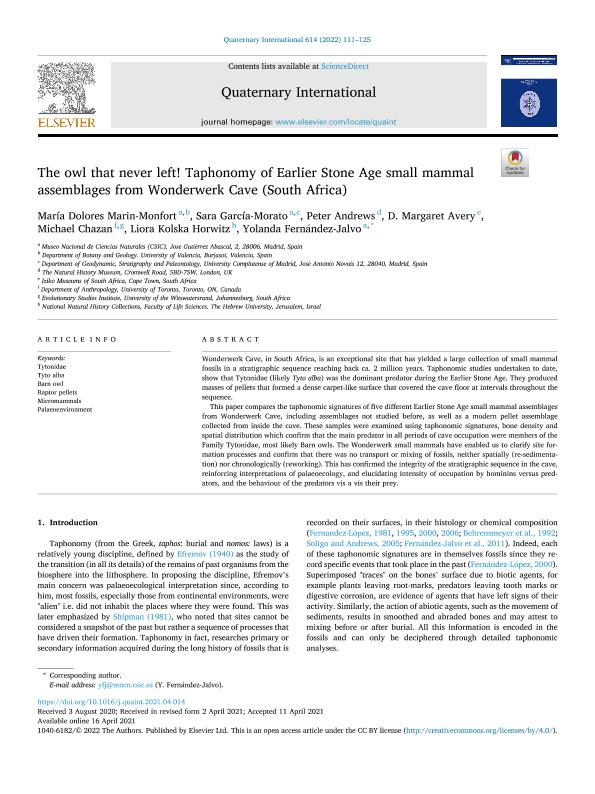Artículo
The owl that never left! Taphonomy of Earlier Stone Age small mammal assemblages from Wonderwerk Cave (South Africa)
Marin Monfort, María Dolores ; García Morato, Sara; Andrews, Peter; Avery, D. Margaret; Chazan, Michael; Horwitz, Liora Kolska; Fernandez Jalvo, Yolanda
; García Morato, Sara; Andrews, Peter; Avery, D. Margaret; Chazan, Michael; Horwitz, Liora Kolska; Fernandez Jalvo, Yolanda
 ; García Morato, Sara; Andrews, Peter; Avery, D. Margaret; Chazan, Michael; Horwitz, Liora Kolska; Fernandez Jalvo, Yolanda
; García Morato, Sara; Andrews, Peter; Avery, D. Margaret; Chazan, Michael; Horwitz, Liora Kolska; Fernandez Jalvo, Yolanda
Fecha de publicación:
16/04/2022
Editorial:
Pergamon-Elsevier Science Ltd
Revista:
Quaternary International
ISSN:
1040-6182
Idioma:
Inglés
Tipo de recurso:
Artículo publicado
Clasificación temática:
Resumen
Wonderwerk Cave, in South Africa, is an exceptional site that has yielded a large collection of small mammal fossils in a stratigraphic sequence reaching back ca. 2 million years. Taphonomic studies undertaken to date, show that Tytonidae (likely Tyto alba) was the dominant predator during the Earlier Stone Age. They produced masses of pellets that formed a dense carpet-like surface that covered the cave floor at intervals throughout the sequence. This paper compares the taphonomic signatures of five different Earlier Stone Age small mammal assemblages from Wonderwerk Cave, including assemblages not studied before, as well as a modern pellet assemblage collected from inside the cave. These samples were examined using taphonomic signatures, bone density and spatial distribution which confirm that the main predator in all periods of cave occupation were members of the Family Tytonidae, most likely Barn owls. The Wonderwerk small mammals have enabled us to clarify site formation processes and confirm that there was no transport or mixing of fossils, neither spatially (re-sedimentation) nor chronologically (reworking). This has confirmed the integrity of the stratigraphic sequence in the cave, reinforcing interpretations of palaeoecology, and elucidating intensity of occupation by hominins versus predators, and the behaviour of the predators vis a vis their prey.
Palabras clave:
BARN OWL
,
MICROMAMMALS
,
PALAEOENVIRONMENT
,
RAPTOR PELLETS
,
TYTO ALBA
,
TYTONIDAE
Archivos asociados
Licencia
Identificadores
Colecciones
Articulos(INGEOSUR)
Articulos de INST.GEOLOGICO DEL SUR
Articulos de INST.GEOLOGICO DEL SUR
Citación
Marin Monfort, María Dolores; García Morato, Sara; Andrews, Peter; Avery, D. Margaret; Chazan, Michael; et al.; The owl that never left! Taphonomy of Earlier Stone Age small mammal assemblages from Wonderwerk Cave (South Africa); Pergamon-Elsevier Science Ltd; Quaternary International; 614; 16-4-2022; 111-125
Compartir
Altmétricas



